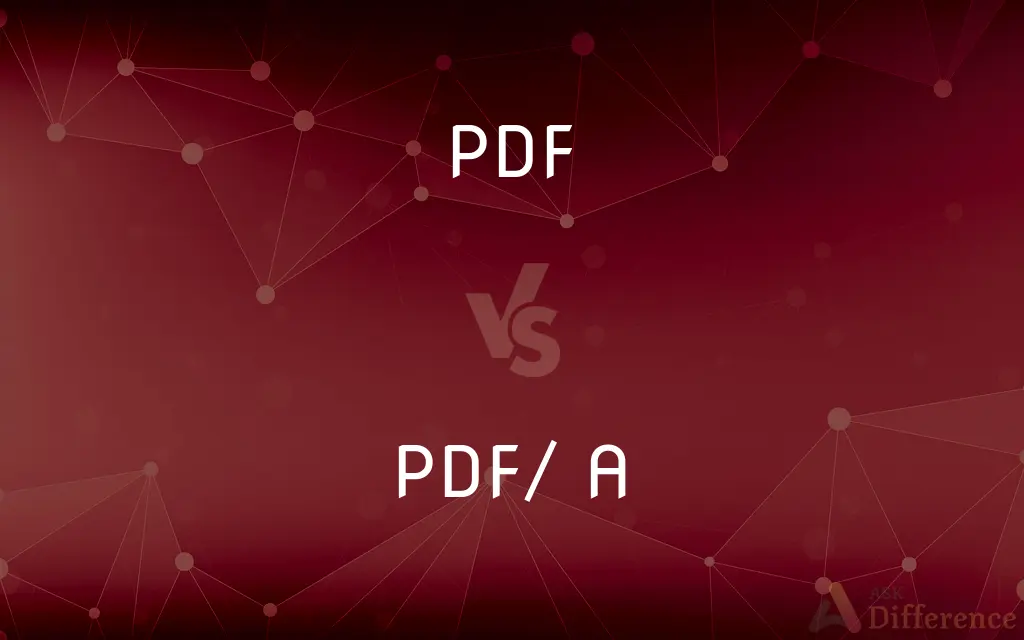PDF vs. PDF/ A — What's the Difference?
By Maham Liaqat & Urooj Arif — Published on March 2, 2024
PDF is a versatile format for documents, supporting interactive functions, while PDF/A is a subset designed for long-term archiving, prioritizing stability over interactivity.

Difference Between PDF and PDF/ A
Table of Contents
ADVERTISEMENT
Key Differences
PDF (Portable Document Format) is widely used for distributing digital documents that include text, images, and interactive elements like hyperlinks, forms, and multimedia content. PDF/A, on the other hand, is a version of PDF specifically standardized for archiving and long-term preservation of electronic documents, stripping away features that may not be reliable over long periods, such as dynamic content and external references.
One of the key differences lies in their intended use. PDFs are designed to be dynamic, easily shared, and used for a wide range of purposes, including business, education, and personal use. PDF/A, however, focuses on ensuring that documents can be reliably accessed and remain unchanged over many years, making it ideal for storing official records, legal documents, and other important archives.
PDF supports a wide range of content types, including interactive forms, annotations, and multimedia elements. These features make PDFs highly versatile but can also depend on external factors like software versions or linked content, which may change over time. Conversely, PDF/A prohibits these elements to ensure that the document appearance remains consistent and self-contained, avoiding the risk of content loss or alteration.
Compatibility is another distinguishing factor. Most PDF readers and editors can open and sometimes edit PDF/A documents, but when saving a document as PDF/A, specific validation tools are often used to ensure compliance with the standard. This compliance ensures the document's longevity and accessibility across different computing environments over time.
Both formats can be used for digital documentation, while choosing between PDF and PDF/A depends on the document's purpose. For interactive and easily shared documents, PDF is the preferred choice. For archival purposes where preservation is key, PDF/A is the better option, ensuring that the document's integrity is maintained for future generations.
ADVERTISEMENT
Comparison Chart
Purpose
General document use and distribution
Long-term archival and preservation
Interactivity
Supports interactive elements
Prohibits interactive elements
Content Type
Dynamic content, multimedia
Static, ensures long-term readability
Compatibility
Broad compatibility with viewers
Requires compliance for archival
Longevity Concerns
Not specifically designed for longevity
Designed to maintain integrity over time
Compare with Definitions
Allows encryption and digital signatures for document security.
The contract was sent as a secured PDF, requiring a digital signature.
PDF/ A
The archive used PDF/A-2 for its enhanced color management features.
Ideal for storing documents that require long-term access without alteration.
Can be created and edited with a wide range of software.
She created a PDF brochure using design software to include hyperlinks.
PDF/ A
Ensures documents can be reproduced exactly the same way in the future.
The museum stored its exhibition catalogs in PDF/A to ensure future accessibility.
A format for documents that combines text, graphics, and interactive elements.
The company distributed its annual report as a PDF including embedded videos.
PDF/ A
Has several conformance levels (
PDF/A-1, PDF/A-2) for different needs.
Supports various compression methods to reduce file size.
The PDF was compressed to make it easier for email distribution.
PDF/ A
A version of PDF for archiving, omitting unstable content like links.
The government archives its documents in PDF/A for preservation.
Widely used for digital forms and documents on the web.
The application form was downloaded as a fillable PDF.
PDF/ A
Prohibits encryption and requires embedded fonts for self-containment.
The PDF/A document embedded all fonts to avoid future compatibility issues.
Initialism of probability density functionCategory:en:Functions
PDF/ A
Legal documents are often converted to PDF/A for archival.
Alternative case form of PDF
Common Curiosities
Why can't I use interactive features in a PDF/A document?
PDF/A aims to ensure documents remain readable and unchanged over time, so it prohibits potentially unstable features like multimedia.
Why would an organization choose PDF/A over PDF?
Organizations opt for PDF/A to ensure critical documents are preserved accurately for legal, historical, or archival purposes.
How do I identify if a document is PDF/A?
PDF/A documents often have a metadata tag indicating their conformance level, and some PDF readers display a banner noting the document is in PDF/A format.
What's the main difference between PDF and PDF/A?
PDF supports interactive content for broad use, while PDF/A is optimized for preserving documents long-term without interactive elements.
Is PDF/A compatible with all PDF readers?
Most PDF readers can open PDF/A documents, but editing might be restricted to preserve compliance with the archival standard.
Can PDF/A files contain images?
Yes, PDF/A files can contain images, but these must be embedded within the document to maintain self-sufficiency.
What are the different conformance levels of PDF/A?
PDF/A has several conformance levels, such as PDF/A-1 for basic requirements, PDF/A-2 for more color and transparency features, and PDF/A-3 for embedding non-PDF/A files.
Is PDF/A suitable for everyday document use?
While PDF/A can be used daily, its restrictions make it more suited for archival purposes than for documents requiring interaction.
Are there legal advantages to using PDF/A?
Yes, PDF/A's stability and self-contained format are often preferred for legal documents, ensuring they remain unaltered over time.
Can PDF/A documents be encrypted?
No, PDF/A standards generally prohibit encryption to ensure content remains accessible in the future.
Can a PDF be converted to a PDF/A?
Yes, a PDF can be converted to PDF/A, but this process may require removing or altering content that's not allowed in PDF/A.
Can I remove the PDF/A status from a document?
Yes, with appropriate software, you can save a PDF/A document as a standard PDF, removing the archival restrictions.
How do I convert a document to PDF/A?
Many PDF creation and editing tools offer the option to save or export documents as PDF/A, often with presets for different conformance levels.
Does converting to PDF/A reduce file size?
Not necessarily; while unnecessary content is removed, the requirement to embed fonts can sometimes increase file size.
Is PDF/A the only format for document preservation?
While PDF/A is widely recognized for document preservation, other formats like TIFF and XML are also used for specific archival needs.
Share Your Discovery

Previous Comparison
FCA vs. FOB
Next Comparison
Holland vs. NetherlandAuthor Spotlight
Written by
Maham LiaqatCo-written by
Urooj ArifUrooj is a skilled content writer at Ask Difference, known for her exceptional ability to simplify complex topics into engaging and informative content. With a passion for research and a flair for clear, concise writing, she consistently delivers articles that resonate with our diverse audience.
















































